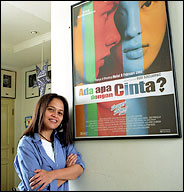June 12, 2002
Boy Kisses Girl: That's Sweet, and Sensational!
By JANE PERLEZ
 |
| Guntur Primagotama/Imaji Press, for The New York Times |
| Mira Lesmana with the poster of her latest hit movie at her house in Jakarta, Indonesia. |
 |
| The New York Times |
| ``What's With Love?'' was partly
shot in the streets of Jakarta. |
 |
| "What's With Love?'' |
| The kiss created a box office sensation. |
JAKARTA, Indonesia, June 10 — It was the kiss. Lips to lips. Not a deep Hollywood smooch, but not a light brush either.
An attractive 16-year-old Indonesian girl and her handsome boyfriend kissing on screen in the Indonesian-made movie "What's With Love?" helped create the box office sensation of the year in this predominantly Muslim country.
Teenage audiences cheered: the boys whistled, the girls murmured. Even adults, who had been expected to disapprove, liked it.
The slick American-style movie shot in the streets of this hyperactive city and in the corridors of a well-to-do high school has outgrossed "Titanic" and "Lord of the Rings," two of the most successful Hollywood imports here.
"We felt we had to show something that's real," said Mira Lesmana, the movie's very hip, very expansive 37-year-old producer and screenwriter.
"There's been too much self-censorship among the older generation. They are so used to Hollywood kissing, but as soon as they see Indonesians kissing they think it will give a bad image. We, the new generation, don't feel that way."
After all, she said, "Indonesians do kiss."
The success of "What's With Love?" says more about Indonesia today than the flutter about one scene. Until now, most Indonesian movies centered on the eternal struggle of rural life. Ms. Lesmana's movie, and a precursor she made a few years ago, "Kuldesak," are urban dramas.
"What's With Love?" is about students from the middle class or above who face quandaries similar to those of their peers in the West. For the first time, broken homes and domestic violence appear in a modern Indonesian movie.
American icons are everywhere in the film. The school cafeteria serves burgers and fries; a
With production costs totaling $400,000, however, the movie cost less than one commercial in the United States. "We joke that it wouldn't even cover the catering costs for one Hollywood movie," she said.
The characters in the movie are Cinta — the word also happens to mean love in Indonesian — and Rangga, the boy with whom she falls in love. She is quite rich; he is not. He is bookish; she is not. She is gregarious, the girl of the moment; he is a loner. She comes from a stable family. His parents are divorced because his mother could not cope when her husband became a political dissident.
They meet in the school library, and a book he is reading, "Aku," about an Indonesian poet, serves as the initial connection. After Cinta falls for Rangga, he tells her that he is going with his father to live abroad, to escape the constraints of Indonesia. The closing airport scene features the kiss.
Ms. Lesmana is unabashed in her admiration for American movies. "Star Wars" and "
She knows "Pulp Fiction" scene by scene. "Clueless," the Beverly Hills high-school movie of the late 1990's, provided some of the inspiration for her current hit. She is eagerly awaiting the arrival of "Spiderman."
Some of the tensions in the movie evolved from her own experiences.
In 1979, her father, Jack, a jazz musician, decided to take the family to Sydney, Australia, so that her brother could study music at a conservatory there. Ms. Lesmana, then 16 and looking forward to the clubby high-school atmosphere in Jakarta, found that she had to adapt to the entirely different culture of Strathfield Girls High School. The serge uniform, heavy duty stockings and single-sex education were too much.
"I had spent most of my time with boys, who were good friends," she said. "You go to a girls' school and they talk about boys as though they are a different species. I thought, `What is this?' "
To make things worse, Ms. Lesmana, who was very proud of her fluent English, could not understand the Australian drawl. She soon transferred to an international coeducational school.
With her passion for film, she decided she wanted to attend the Australian Film and Television School in Sydney, the training ground for Peter Weir, the Hollywood director. But Ms. Lesmana was told she had too little experience to enroll. She decided to return home, and entered the Jakarta Institute of the Arts.
"I liked being home," she said. "I liked the school, I learned a lot."
She graduated in 1988. With the Indonesian film industry under the thumb of the Suharto dictatorship, she made soap, shampoo and food commercials for the next decade.
By the time the Suharto restrictions were lifted four years ago, she was ready. Her first major success came last year with a children's musical movie, "Sherina's Adventure," starring a popular child singer, Sherina Munaf." While there are no current plans to show "What's With Love?" in the United States, an aide to Ms. Lesmana said they planned to submit it to the New York Film Festival.
The measure of Cinta's wholesome appeal came home to Ms. Lesmana in a recent encounter in a shopping mall.
"A young mother, who was wearing a jilbab, approached me," she said, referring to the head covering often worn by Indonesia's Muslim women. "She said: `You're Mira Lesmana? I'm very happy you made the film. Not only were my children entertained, they learned a lot about poetry. Don't worry about the kissing scene. It was very daring but very important that our children learn how to express love.' "
Ms. Lesmana added, "And I thought she was going to scream at me."